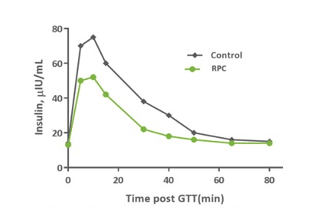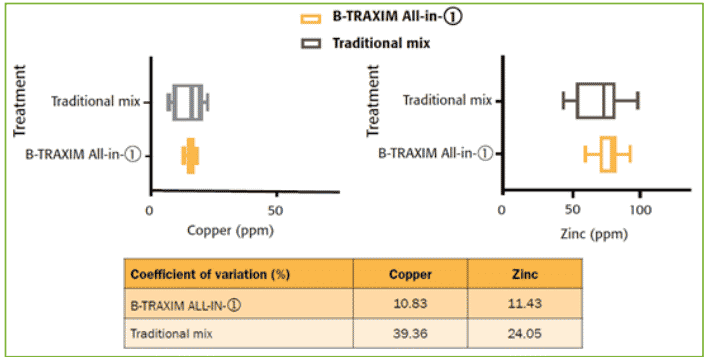Reducing mineral excretion is important for sustainable shrimp production as it reduces the environmental impact. Half doses of organic trace minerals have shown to help maintain shrimp growth performance and feed efficiency, while reducing mineral excretion
By Mieke Zoon, Product Manager Trace Minerals
Strategies for more sustainable shrimp production
The predictability of quality and availability of shrimp has greatly improved, with aquaculture. However, higher inputs and outputs resulting from intensifying production have led to new challenges. In recent years, there has been a lot of attention on more sustainable shrimp production through the use of the following strategies:
- replacing fish meal and fish oil in feed (with vegetable-based and even insect-sourced substitutes),
- reducing environmental effects (with water recycling systems),
- preventing disease (via biosecurity)
- and improving feed efficiency (by optimizing feed and management).
Major improvements have been made in all these areas, but there is still more to be done (FAO, 2018). For example, the lack of an adaptive immune system in shrimp provides an additional challenge for their biosecurity when compared to livestock, as this means that they cannot be vaccinated. The reduction of fish meal and fish oil in shrimp feeds leads to other challenges, not only in replacing high quality protein, but also other nutrients, like minerals, as they are no longer provided in a highly available form.
Trace minerals are known to be important for several metabolic functions, improving not only growth, but also development, fertility, final product quality and immunity. Organic forms of trace minerals, for example B-TRAXIM minerals (PANCOSMA, Switzerland), have been shown to offer higher bioavailability and additional benefits in livestock species compared to traditionally used inorganic forms (Spears et al., 2004; Hansen et al., 2008; Leeson et al., 2008; De Marco et al., 2017; Zhang et al, 2017; Männer & Schlegel, 2006 and Jang et al., 2010). Organic trace minerals may also contribute to improved efficacy in feed formulations and to a reduction in the environmental impact of shrimp production.
Benefits of organic trace minerals (OTM)
In line with more sustainable production methods, OTM can help to reduce the impact of waste from shrimp production on the environment by reducing mineral excretion. Although aquafeeds already contain much less fish meal and fish oil than before, they remain as important ingredients, especially for high value and more carnivorous species, such as for shrimp and salmon production (FAO, 2018). The high levels of unsaturated fats from fish sources are a challenge to the stability of aquafeeds. Metal ions, and especially zinc, iron and copper, are known to be major catalyzers of oxidation (McDowell, 2008). If metals are stabilized with an organic bond, this may not only increase their bioavailability, but reduce oxidation of important nutrients as well.
OTM on growth and immune parameters in shrimp
After earlier confirmation of the practical advantages and the potential positive impact of using OTM on shrimp performance, commercial use of glycine based OTM has begun both in Latin America and Southeast Asia. To confirm the positive benefits of OTM, a new trial in a controlled environment was set up in Thailand by Professor Orapint Jintasataporn (Department of Aquaculture, Faculty of Fisheries, Kasetsart University, Thailand). In this trial, the effect of OTM on the growth performance and immune parameters of white shrimp (Litopenaeus vannamei) was studied. The shrimp were fed either a non-supplemented diet (negative control, NC), or subjected to one of the following treatments: a full dose of inorganic minerals (positive control, PC), a full dose of B-TRAXIM minerals (BT1X), or a half dose of B-TRAXIM minerals (BT0.5X). Shrimp fed BT1X showed the fastest growth, best feed conversion and numerically the highest survival. The total shrimp production per tank will be of interest to shrimp producers, as it combines the result of growth performance and survival rate in one parameter. The glycine based OTM (BT1X) consistently showed the highest production.
Optimizing dose levels of organic trace minerals in shrimp production
Another interesting trial carried out in this study was to reduce inorganic mineral supplementation by 50% and instead use OTM (BT0.5X). This has been shown to maintain growth performance and feed efficiency, while reducing mineral excretion. This is fully in line with results from other species, e.g. in broilers (De Marco et al., 2017). In the same trial some important immunity parameters were checked. This is of interest as disease-related mortality in shrimp production is a common issue. Stimulating general immunity and optimizing the immune response are important, as vaccination is not possible because shrimp rely only on their innate immune system. Lysozyme is an enzyme with antibacterial properties which acts as part of the innate immune system by cutting the carbohydrate chains forming the main structure of bacterial cell walls (Lacono et al., 1980).
The BT1X shrimp showed a significant increase of lysozyme activity in the hemolymph (which plays the same role as blood in mammals). Also, superoxide-dismutase (SOD) activity, as part of the antioxidant system, showed a trend towards higher levels in the hemolymph of BT1X shrimp. The increased levels of lysozyme and SOD activities showed that the BT1X shrimp had an improved ability to protect themselves against bacterial and oxidative challenges. More sustainable shrimp Summarizing the results from available trial data as well as practical experience, the glycine based
Reducing environmental impact of shrimp production with organic trace minerals
Organic trace minerals have been shown to be able to support shrimp producers in mitigating some of their main challenges towards better sustainability. Mineral excretion into the aquatic environment by shrimp can be reduced with OTM supplementation in shrimp feeds. An efficient immune response was also supported, which could reduce the impact of disease and improve growth and feed efficiency, allowing for a better return on investment. OTM will not solve all the challenges faced in aquaculture, but it can be used as a solution to support shrimp producers on their path towards a more sustainable way to provide high quality food globally.
Related articles
Pancosma aquaculture feed additives
Pancosma organic trace minerals
References
FAO, 2018. The State of World Fisheries and Aquaculture 2018 – Meeting the sustainable development goals. Rome. License: CC BY-NC-SA 3.0 IGO De Marco, M., M.V. Zoon, C. Margetyal, C. Picart, C. Ionescu, 2017. Dietary administration of glycine complexed trace minerals can improve performance and slaughter yield in broilers and reduces mineral excretion. Animal Feed Science and Technology 232: 182- 189. Hansen, S.L., P. Schlegel, L.R. Legleiter, K.E. Lloyd, J.W.
Spears, 2008. Bioavailability of copper from copper glycinate in steers fed high dietary sulfur and molybdenum. Journal of Animal Science 86: 173-179.
Jang, Y.D., H.B. Choi, S. Durosoy, P. Schlegel, B.R. Choi, Y.Y. Kim, 2010. Comparison of bioavailability of organic selenium sources in finishing pigs. Asian-Australian Journal of Animal Science, Vol. 23, No. 7: 931-936.
Lacono, V. J., B.J. MacKay, S. DiRienzo, J.J. Pollock, 1980. Selective antibacterial properties of lysozyme for oral microorganisms. Infection and Immunity, 29: 623-632. Leeson, S., H. Namkung, L.
Caston, S. Durosoy, P. Schlegel, 2008. Comparison of selenium levels and sources and dietary fat quality in diets for broiler breeders and layer hens. Poultry Science 87: 2605-2612.
Männer, K., O. Simon, P. Schlegel, 2006. Effects of different iron, manganese, zinc and copper sources (sulphates, chelates, glycinates) on their bioavailability in early weaned piglets. In: M. Rodehutscord (Hrsg.): 9. Tagung Schweine[1]und Geflügelernährung, 28.-30, 2006. Institut für Agrar- und Ernährungswissenschaften, Universität Halle-Wittenberg. ISBN: 3-86010-833-6.
McDowell, L.R., 2008. Vitamins in Animal and Human Nutrition. John Wiley & Sons, p. 714-716.
Spears, J.W., P. Schlegel, M.C. Seal, K.E. Lloyd, 2004. Bioavailability of zinc from zinc sulfate and different organic zinc sources and their effects on ruminal volatile fatty acid proportions. Livestock Production Science 90: 211-217.
Zhang, L., Y.X. Wang, X. Xiao, J.S. Wang, Q. Wang, K.X. Li, T.Y. Guo, X.A. Zhan, 2017. Effects of zinc glycinate on productive and reproductive performance, zinc concentration and antioxidant status in broiler breeders. Biological Trace Element Research 178 (2): 320-326.


